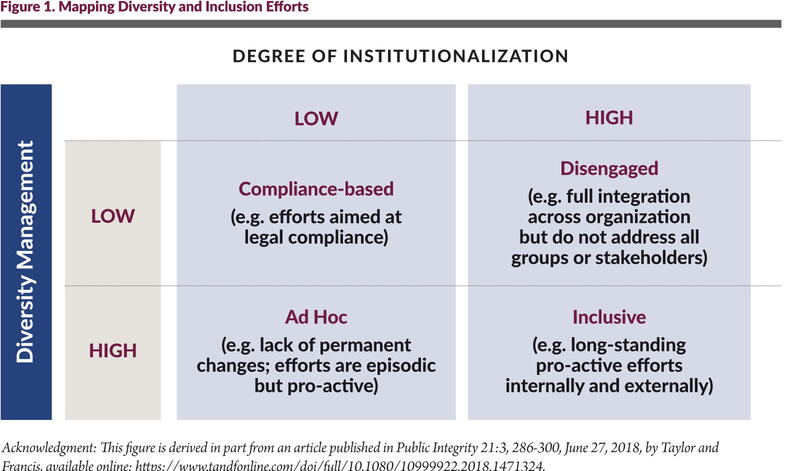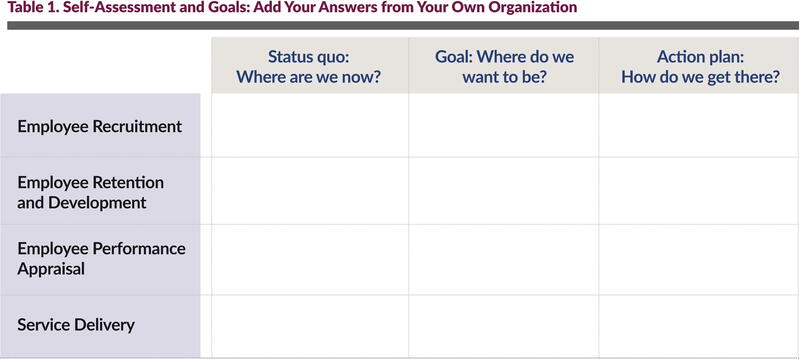
BY JONATHAN M. FISK, GEOFFREY A. SILVERA, COURTNEY N. HAUN, JEFFREY DOWNES, NATHAN EBERLINE, AND PHILLIP SMITH-HANES
Public administrators need to not only assess their organization’s level of diversity and inclusion, but also be equipped to align such efforts with their strategic goals. A recent article by a group of academic scholars (Fisk, Silvera, and Haun) has provided a framework to map and understand organizational efforts aimed at diversity and inclusion. In addition to a brief description of this framework, local government administrators (Downes and Smith-Hanes) have provided commentary on the usefulness of this framework in practice and their own strategies for improving diversity and inclusion.
Defining Diversity and Inclusion
For current purposes, diversity management can be considered a set of surface-level and deeper-level tools, rules, and policies that encourage diversity based on the presumed performance benefits associated with an inclusive workforce.1 In short, diversity management includes a range of voluntary actions that address diversity both in long-term strategic planning and in the more short-term activities of managers and employees.2 Organizations opt to pursue diversity and inclusion for a number of reasons3 :
- To deepen employees’ and other stakeholders’ knowledge of the backgrounds, beliefs, and values of their employees and stakeholders. Equipped with this knowledge, they can then modify their policies, practices, and programs to improve how they deliver goods and services. To satisfy goals and priorities outlined in their mission statements or strategic plans.4
- To satisfy applicable employment laws.
- To increase employee engagement within the organization.5
- To respond to a diversifying population of customers/residents and other stakeholders.
- To create organizations that capitalize on the diverse collection of employees’ backgrounds, knowledge, and experiences to develop greater problem-solving capacity.6
Thinking About Diversity in Organizations
In an article in Public Integrity,we described a typology of diversity and inclusion efforts in organizations.7 The typology is intentionally nonprescriptive and does not suggest that all organizations should seek to be inclusive of all groups at all times, as organizations have various needs and goals with regard to diversity management. Instead, the typology offers administrators a tool by which to evaluate their current practices and assess whether they are appropriate to achieve their desired organizational outcomes. The typology uses the management theory of institutionalization8 to assess the degree to which the diversity management practices become incorporated within the organization.
Figure 1 illustrates the typology of diversity and inclusion efforts by placing them in four quadrants, based on the degree of institutionalization and the degree of diversity management.

- Compliance-based efforts are characterized by low commitment or ability to support and/or engage with the voluntary programs associated with diversity and a low degree of institutionalization. The reason may be limited financial or human capital that impedes efforts to diversify the workforce. In short, organizational efforts target legal compliance rather than efforts that go beyond compliance.9
- Ad-hoc efforts depend on a particular employee, group of employees, or organizational unit that demonstrates a significant commitment to supporting diversity. However, because these actions are not enshrined in official organizational policy or practice, they are likely to possess a low degree of institutionalization or utilization across the organization. In other words, efforts in this quadrant are likely to be voluntary, siloed, short term, and/or temporary rather than long term, sustainable, and permanent.
- Disengaged efforts are characterized by low commitment to diversity in organizations that do have well-established programs. These programs, however, are few in number and are likely operating as silos, meaning that they have very little integration across the organization despite having access to resources. For example, an organization may have an employee recruitment program for one stakeholder group, but fail to engage with other groups that it is likely to serve, or is otherwise neglected by organizational leadership.
- Inclusive efforts define an organization that dedicates resources so that its efforts to improve diversity are widespread, sustainable, and designed to empower employees.10
Developing Diversity and Inclusion: So What?
As a first step in looking at the diversity and inclusion practices in your own organization, you can use Figure 1 to place your organization in the quadrant you feel best describes the organization as a whole. You might also use the tool to “map” administrative subunits or organizational functions as recruitment, development, performance management, and service delivery. It may also be helpful to ask these important questions:
- Where is my organization in Figure 1? Do all members of my team feel this way?
- Is this where we want our organization to be?
- If not, how can we get to where we want to be?
Table 1 provides a way of organizing answers to these questions to begin the conversation and organizational self-reflection.

Goal Identified: Now What?
A variety of mechanisms are available to organizations that seek to implement diversity programs or to move their efforts into a different quadrant in Figure 1. These mechanisms can be high-cost or low-cost, strategic or tactical, preventive or reactive. Moving from “so what” to “now what” offers organizations the opportunity to examine and consider tools that reflect their specific needs, strengths, weaknesses, and opportunities. Table 2 shows some options.

Perspectives from the Field
It’s important to note that many of the programs described in Table 2 have significant associated costs in terms of staff time and money. While there‘s a business case for diversity, it may be that some organizations do not have the time or resources to support an internship program, conduct a barrier analysis, or build relationships with specific groups in the community (outside of what they already do).
Recognizing that many local governments have limited resources, we are sharing two suggestions of low- or no-cost options that are already being utilized in public sector organizations.
The Platinum Rule (by City Manager Jeffrey Downes, Vestavia Hills, Alabama). I face daily interactions with internal staff, elected officials, and external stakeholders that all have different points of view. To be a successful public servant, I have to treat every situation as unique and understand the history being brought to me on the particular interaction. Reaching into my toolkit, one of my very favorite and most productive tools is something I call the Platinum Rule.
The Platinum Rule was introduced to me very early in my career and in essence is a variation of the Golden Rule: Treat others as you would like to be treated. The Platinum Rule emphasizes that you should treat others the way theywant to be treated.11
Everyone is different. Everyone has different motivators. If you understand your audience and react based upon their innate needs, you can be successful building a team or working together to accomplish many tasks. I can think of many ways exercising this rule has produced results for my team and me.
I remember hiring a very talented economic development professional who made a move from academia. He was not used to working in a bureaucratic environment where hierarchy and reporting relationships were an important context to success. His theoretical basis for actions was accurate, but his ability to navigate the bureaucracy made for implementation issues. Understanding his mindset was important to keeping his energy and enthusiasm intact. I could not treat him as I do a 20-year government veteran; I had to understand how to create an environment unique to his needs for him to be successful.
My evaluation of the outcome of this effort was that many successful projects reached fulfillment due to adjusting my standard management based upon the unique needs of my employee. The Platinum Rule helped guide that particular challenge. Whether the situation involves a citizen complainant who is especially sensitive to noise or an elected official wanting only a concise summary of a project opportunity, I have seen success in altering my style to accommodate their needs.
How can one become proficient in using this tool? There are several ways. Simple listening without knee-jerk reactions is one way. Probing different means of motivation is another. However, when dealing with your staff or teammates, the use of training environments is most helpful. Myers-Briggs or DISC assessments completed in a nonthreatening training environment can really help in formally learning your audience.
If that information is then actually used to inform your actions, a powerful formula can be unleashed. I do not treat introverts the same way that I treat extroverts. Don’t spring an idea on an introvert and expect an immediate solution. Engage a team of extroverts on brainstorming exercises in a fun environment and awesome ideas will be generated. The key here, again, is that success demands that you understand the individuals with whom you are working.
Self-Reflection and Listening (by County Administrator Phillip Smith-Hanes, Ellis County, Kansas). One route to becoming more aware, sensitive, and knowledgeable is through self-reflection and listening. One low-cost and easy way to accomplish this is to ask others about their experience and “then shut up.” This requirement means shutting up not only outwardly, but silencing internal reactions as well.
Listening to others to understand their point of view can break down barriers with regard to generational differences, as well as race or gender. In fact, I had a personal experience with this earlier this year when a millennial broke down in tears in a class I was in because she felt others in the class were making (unfair and incorrect) assumptions about her based on her age. She was genuinely hurt by the “funny” comments about millennials that those of us from older generations sometimes let fly.
The second useful tool is to do some self-work and be aware of when your own personal values are transgressed by the actions of others. For example, I was raised to believe that with hard work I can achieve anything, and excuses are not acceptable. It tends to drive me crazy when people start expressing their own victimization by an organizational environment.
I have to acknowledge that my value system is shaped by an upper-middle-class, white, Protestant, English-speaking upbringing by parents who were born into one of the most upwardly mobile generations the planet has ever seen. Not everyone has had even a fraction of the advantages I have had within the economic and political system, and I have to listen to others’ stories from their perspective rather than my own.
Key Takeaways
The goal of this article is to provide insights into diversity and resources for the intentional diversification of public service organizations. We have provided an assessment tool germane to the improvement of diversity and inclusion, as well as some low- to no-cost interventions. These are designed to precipitate difficult and honest conversations, to promote organizational growth and development, and to reinforce the core values of public service.






Endnotes and Resources
1 Klingner, D., Nalbandian, J., & Llorens, J. J. (2018). Public personnel management : Context and Strategies(Seventh). Routledge. 155-178.
2 Thomas, R. (1990). From affirmative action to affirming diversity. Harvard Business Review,107–117. March-April 1990.
3 Rice, M. (2007). Promoting Cultural Competency in Public Administration and Public Service Delivery: Utilizing Self-Assessment Tools and Performance Measures on JSTOR. Journal of Public Affairs Education,13(1), 41–57.
4 Norman-Major, K. A., & Gooden, S. T. (2014). Cultural competency for public administrators. Routledge.
5 Fisk, J. M., Silvera, G. A., & Haun, C. N. (2018). Developing and Defining Diversity. Public Integrity.https://doi.org/10.1080/10999922.2018.1471324
6 U.S. Office of Personnel Management. Governmentwide Inclusive Diversity Strategic Plan 2016. Retrieved from https://www.opm.gov/policy-data-oversight/diversity-and-inclusion/reports/governmentwide-inclusive-diversity-strategic-plan-2016.pdf
7 Fisk, J. M., Silvera, G. A., & Haun, C. N. (2018). Developing and Defining Diversity. Public Integrity.https://doi.org/10.1080/10999922.2018.1471324.
8 DiMaggio, P. J., & Powell, W. W. (1983). The iron cage revisited: Institutional isomorphism and collective rationality in organizational fields. American sociological review,147-160.
9 Koys, D. J. (1991). Fairness, Legal Compliance, and Organizational Commitment. Employee Responsibilities and Rights Journal,4(4), 283–291.
10 Sabharwal, M. (2014). Is diversity management sufficient? Organizational inclusion to further performance. Public Personnel Management,43(2), 197–217.
11 Winston, B. E. (2002). Be a leader for God’s sake: From values to behaviors. Virginia Beach, VA.
New, Reduced Membership Dues
A new, reduced dues rate is available for CAOs/ACAOs, along with additional discounts for those in smaller communities, has been implemented. Learn more and be sure to join or renew today!
